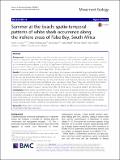Files in this item
Summer at the beach : spatio-temporal patterns of white shark occurrence along the inshore areas of False Bay, South Africa
Item metadata
| dc.contributor.author | Kock, Alison A. | |
| dc.contributor.author | Photopoulou, Theoni | |
| dc.contributor.author | Durbach, Ian | |
| dc.contributor.author | Mauff, Katya | |
| dc.contributor.author | Meÿer, Michael | |
| dc.contributor.author | Kotze, Deon | |
| dc.contributor.author | Griffiths, Charles | |
| dc.contributor.author | O'Riain, M. Justin | |
| dc.date.accessioned | 2018-05-22T08:30:06Z | |
| dc.date.available | 2018-05-22T08:30:06Z | |
| dc.date.issued | 2018-05-22 | |
| dc.identifier.citation | Kock , A A , Photopoulou , T , Durbach , I , Mauff , K , Meÿer , M , Kotze , D , Griffiths , C & O'Riain , M J 2018 , ' Summer at the beach : spatio-temporal patterns of white shark occurrence along the inshore areas of False Bay, South Africa ' , Movement Ecology , vol. 6 , 7 . https://doi.org/10.1186/s40462-018-0125-5 | en |
| dc.identifier.issn | 2051-3933 | |
| dc.identifier.other | PURE: 253120269 | |
| dc.identifier.other | PURE UUID: 88a9d80f-a065-4867-9c72-33de34400a2b | |
| dc.identifier.other | Scopus: 85047304136 | |
| dc.identifier.other | ORCID: /0000-0001-9616-9940/work/45160478 | |
| dc.identifier.uri | https://hdl.handle.net/10023/13435 | |
| dc.description | Bursary funding for AAK was provided for her MSc research from the National Research Foundation and for her PhD research through a grant to CG from the National Research Foundation (South Africa) (www.nrf.ac.za) SEAChange Programme. The Department of Environmental Affairs provided additional research equipment and ship time. The Save Our Seas Foundation provided a grant to AAK to conduct this research. | en |
| dc.description.abstract | Background: Understanding white shark (Carcharodon carcharias) habitat use in coastal areas adjacent to large cities, is an important step when formulating potential solutions to the conservation conflict that exists between humans and large predatory sharks. In this study, we present the findings of a 2.5-year study of white shark occurrence and movement patterns adjacent to the City of Cape Town in False Bay, South Africa, with a focus on spring and summer months. Fifty-one white sharks were monitored annually at three offshore and twelve inshore sites by VR2 acoustic receivers, over 975 days from 1 May 2005 to 31 December 2007. Results: Occurrence patterns at inshore sites during spring and summer were analysed using a generalized additive mixed model (GAMM) with a spatial term (longitude, latitude), time of day and year included as explanatory variables for site use. We found that sharks occurred more frequently at inshore sites along the northern and northwestern shores, compared to the rest of the bay, and they transitioned most frequently between four adjacent beach sites that encompass the most popular recreational water use areas in Cape Town. There was significant diel variation, with higher shark occurrence around midday, and a peak in shark occurrence in 2005, when human-shark interactions also peaked. However, we found no effect of shark size on occurrence patterns at inshore sites. Conclusions: White sharks showed the highest levels of occurrence at specific inshore sites between Muizenberg and Strandfontein beach, and thus inclusion of these sites within False Bay’s marine protected area (MPA) network or recognition as Ecological or Biological Significant Areas (EBSAs) should be a future consideration. These insights into white shark habitat use at inshore sites in False Bay are important for successfully applying the principles of marine spatial planning (MSP) and for making science-based policy decisions. Furthermore, this information can be used to reduce potential shark-human conflict by incorporating it into future shark safety education campaigns. | |
| dc.format.extent | 13 | |
| dc.language.iso | eng | |
| dc.relation.ispartof | Movement Ecology | en |
| dc.rights | © The Author(s). 2018. Open Access. This article is distributed under the terms of the Creative Commons Attribution 4.0 International License (http://creativecommons.org/licenses/by/4.0/), which permits unrestricted use, distribution, and reproduction in any medium, provided you give appropriate credit to the original author(s) and the source, provide a link to the Creative Commons license, and indicate if changes were made. The Creative Commons Public Domain Dedication waiver (http://creativecommons.org/publicdomain/zero/1.0/) applies to the data made available in this article, unless otherwise stated. | en |
| dc.subject | White shark | en |
| dc.subject | Carcharodon carcharias | en |
| dc.subject | Telemetry | en |
| dc.subject | Habitat use | en |
| dc.subject | Marine protected area | en |
| dc.subject | Marine spatial planning | en |
| dc.subject | Conservation | en |
| dc.subject | False Bay | en |
| dc.subject | Cape Town | en |
| dc.subject | QH301 Biology | en |
| dc.subject | NDAS | en |
| dc.subject | SDG 14 - Life Below Water | en |
| dc.subject.lcc | QH301 | en |
| dc.title | Summer at the beach : spatio-temporal patterns of white shark occurrence along the inshore areas of False Bay, South Africa | en |
| dc.type | Journal article | en |
| dc.description.version | Publisher PDF | en |
| dc.contributor.institution | University of St Andrews. School of Biology | en |
| dc.contributor.institution | University of St Andrews. Centre for Research into Ecological & Environmental Modelling | en |
| dc.identifier.doi | https://doi.org/10.1186/s40462-018-0125-5 | |
| dc.description.status | Peer reviewed | en |
This item appears in the following Collection(s)
Items in the St Andrews Research Repository are protected by copyright, with all rights reserved, unless otherwise indicated.

